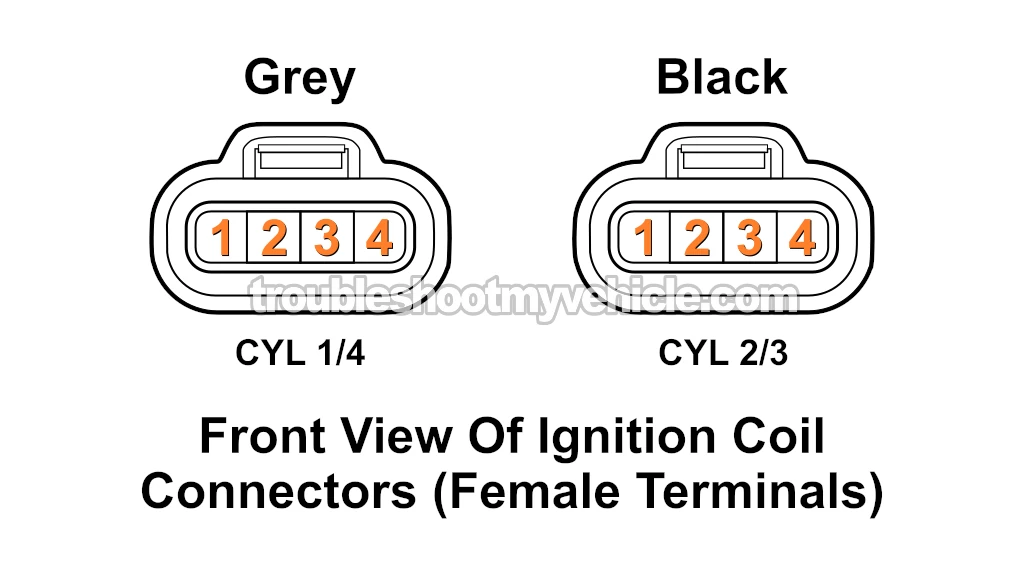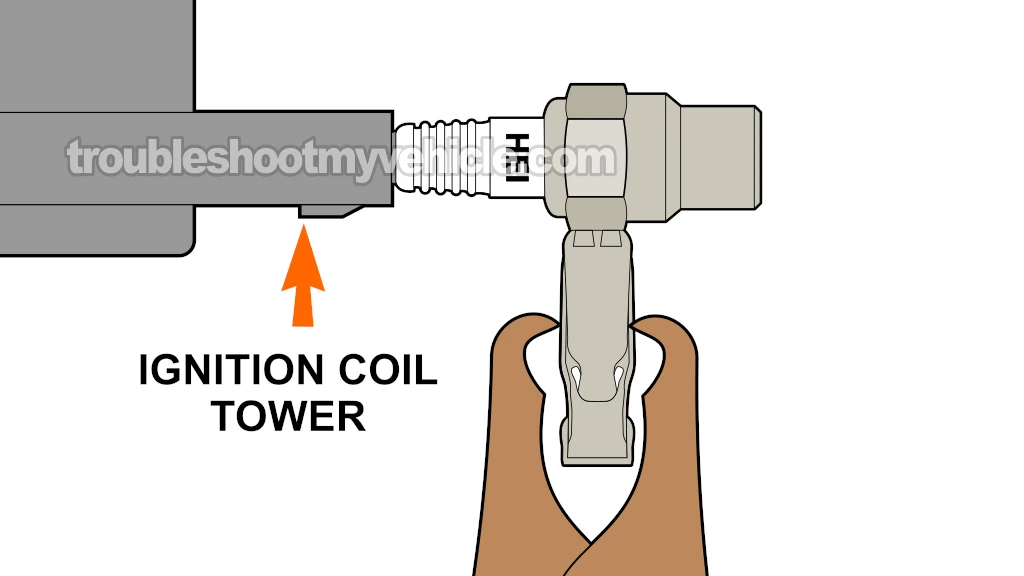TEST 5: Checking For The Ignition Coil's Activation Signal

Up to this point in your diagnostic, you've confirmed a few key things:
- The spark plug wires connected to the same ignition coil aren't sparking (TEST 1).
- Neither of the ignition coil towers are sparking (TEST 3).
- The ignition coil is getting power (TEST 4).
We're now gonna check if this non-sparking ignition coil is receiving an activation (IGT) signal from your Camry's fuel injection computer.
Depending on which ignition coil you're testing, here are the specific wires that deliver the activation signal:
- Ignition Coil 2 (supplies spark to cylinders 1 and 4):
- Connector: Grey.
- Wire: Black (BLK).
- Terminal: 2.
- Ignition Coil 1 (supplies spark to cylinders 2 and 3):
- Connector: Black.
- Wire: Yellow with red stripe (YEL/RED) wire.
- Terminal: 2.
To test for that activation signal, we'll use a multimeter with Hertz capability. If you don't have one and need to buy one, here's my recommendation: Tekpower TP8268 AC/DC Auto/Manual Range Digital Multimeter (at: amazon.com).
Let's get started:
- 1
Put the multimeter in Hertz (Hz) mode.
- 2
Connect the red multimeter test lead to the battery positive (+) terminal.
- 3
Connect the black multimeter test lead to the IGT signal wire using an appropriate tool to either back-probe the connector or pierce the wire.
NOTE: The ignition coil must remain connected to its 4-wire connector.
Coil 1/4: This is the black (BLK) wire of the grey connector.
Coil 2/3: This is the yellow with red stripe (YEL/RED) wire of the black connector. - 4
Have your helper crank the engine while you observe the multimeter.
- 5
You should see fluctuating values of 2 to 20+ Hertz as the engine cranks (and possibly starts) on your multimeter.
Let's see what your test results mean:
CASE 1: The multimeter registered the indicated Hertz values. This is the correct and expected test result and it confirms the ignition coil is getting its activation signal.
The ignition coil is bad, if you've checked and confirmed:
- Both spark plug wires that connect to this ignition coil are not sparking (TEST 1).
- Both ignition coil towers do not spark (TEST 3).
- The ignition coil getting power (TEST 4).
- The ignition coil is receiving its activation signal (this test section).
CASE 2: The multimeter DID NOT register any Hertz value. This test result tells you the ignition coil is missing its activation signal.
The most likely culprit behind this missing signal? An open-circuit problem in the wire that delivers it between the ignition coil's 4-wire connector and the fuel injection computer.
TEST 6: Checking Both Ignition Coils For Spark

NOTE: This test step only applies if all four spark plug wires did not spark in TEST 1.
In this test section, we're gonna check all of the ignition coil towers for spark, one at a time, and see if they're firing off spark.
Here's what we're looking for:
- If all four towers spark: The problem lies with the spark plug wires, and they need to be replaced.
- If none of the towers spark: We'll move on to the next test and make sure they're getting power.
Let's get started!
- 1
Disconnect the cylinder 1 spark plug wire from its ignition coil tower.
NOTE: The other spark plug wires must remain connected to their respective ignition coil towers during this test. Only disconnect a wire when its corresponding ignition coil tower is being tested. - 2
Insert the spark tester in the ignition coil's tower, as shown in the illustration above.
- 3
Ground the HEI spark tester with a battery jump start cable directly on the battery negative (-) terminal.
The battery jump-start cable will also hold the spark tester in place. - 4
Have a helper crank the engine while you observe the spark tester.
- 5
The spark tester should spark.
- 6
Remove the spark tester and reconnect the spark plug wire back on the ignition coil tower.
- 7
Repeat steps 1 thru 6 on the other ignition coil towers that feed spark to cylinders 4, 2, and 3.
Let's take a look at what your test results mean:
CASE 1: The spark tester sparked in all towers. This test result confirms that the spark plug wires are bad.
Replace the spark plug wires if you have:
- Confirmed that the spark plug wires DO NOT spark (TEST 1).
- Confirmed that all four ignition coil towers sparked (this test section).
CASE 2: The spark tester DID NOT spark in all four towers. The next step is to make sure that both ignition coils are getting power.
For this test, go to: TEST 7: Making Sure Both Ignition Coils Are Getting Power.
TEST 7: Making Sure Both Ignition Coils Are Getting Power

If you've reached this point, your test results confirm:
- None of the spark plug wires spark (TEST 1).
- None of the four ignition coil towers are sparking (TEST 6).
In this section, we'll use a multimeter to check if both non-sparking ignition coils are receiving power (10–12 Volts DC).
Key details for testing power supply:
- On both the grey and black connectors, female terminal number 1 supplies 10–12 Volts DC to each ignition coil.
- This terminal connects to a black with red stripe (BLK/RED) wire.
If power is available, we'll move on to the next test, which is making sure that each ignition coil is getting an activation signal from the fuel injection computer.
Let's get started:
- 1
Disconnect the Cyl 1/4 ignition coil from its electrical connector.
- 2
Place your multimeter in Volts DC mode.
- 3
Connect the black multimeter test lead to the battery negative (-) terminal.
- 4
Turn the key to the ON position but don't crank or start the engine.
- 5
With the red multimeter test lead, probe the female terminal labeled with the number 1 (see the photo above).
Verify that female terminal number 1 corresponds to the BLK/RED wire of the connector. - 6
Your multimeter should register 10 to 12 Volts DC.
- 7
Repeat steps 1 thru 6 on the Cyl 2/3 ignition coil.
Let's take a look at what your test results mean:
CASE 1: Both ignition coils are receiving 10 to 12 Volts DC. This is the correct and expected test result.
Your next step is to check if both ignition coils are receiving their activation signals. Go to: TEST 8: Checking The Ignition Coils' Activation Signals.
CASE 2: The ignition coils are not receiving 10 to 12 Volts. Without power, the ignition coils won't create and deliver spark to their cylinders.
The most likely cause of these missing 10 to 12 Volts is an open-circuit problem in the BLK/RED of the ignition coil's 4-wire connector.
Your next step is to find and repair the cause of this missing voltage.
